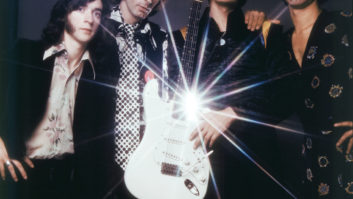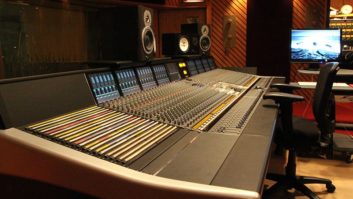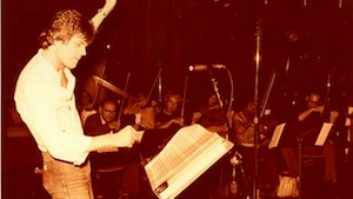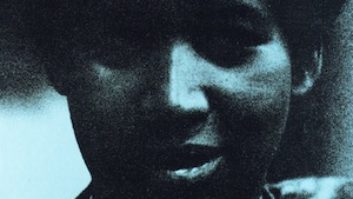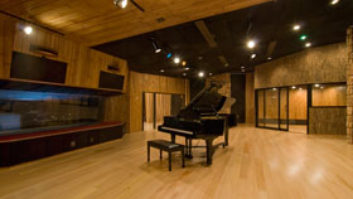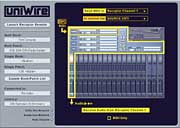
With the holiday season upon us, game freaks and new-wave audio tech heads have much to talk about. Gears of War was recently released by my old friends at Epic Games, and the sound is incredible — even though no real-time mixing was involved — and is getting rave reviews.
While perusing new releases in the audio world (not just videogames) for holiday gifts (for others and myself), I got to thinking about the way I manage my personal audio and how it connects with my game projects and how that has changed more than I ever could have imagined. For the first time, audio as a digital object is starting to coalesce before me in everything I do, as I’m sure it has for others. Take a typical day.
WOKE UP, GOT OUT OF BED
I wake up at 7 a.m., mostly because my kids are early risers, but it gives me some time to be in tune with pop culture at my old age of 32. In the shower, I select the “Shower” playlist, as I’m sure hundreds of us do on our portable players, from iPods to Zens to Rios, and for the first time, XM and Sirius portable players. Meanwhile, MP3 capabilities are starting to lead the pack, so the “FM radio” feature is no longer a staple of budget-priced consumer audio devices, and broadcast audio is now at the forefront of cool features.
My company uses a dandy online tool called Mediabase (www.mediabase.com), a database with information on the playlists of (nearly) every commercial radio station in the country. I can listen to the music that I used to compile from FM radio on Maxell cassette tapes and find out which tunes are currently getting the most spins today. I can then “ka-ching” my favorites at the iTunes store. I now understand what our marketing and licensing folks are talking about at meetings, rather than sit there sulking and insisting that we hire a custom composer instead. Mediabase, while it certainly isn’t cheap, is available to artists, as well as game publishers and record labels. (I plan on registering myself.) If you’re an aspiring artist, then head to the Website, talk to Jeff Gelb, encounter his unrivaled professionalism and figure out what it will take to stick it to the competition. This site offers the most honest and data-driven look into what is popular in music. Hats off to Mediabase for compiling such an exhaustive database.
My day continues, the trusty iPod following me on my bike during the daily commute, and here I am wishing I had a backpack that actually could adjust volume from the strap rather than rely on the almost non-functional Sound Check. And, lo and behold, one exists! The Burton Audex has that functionality and more. Now all the company needs to do is add this functionality to CamelBaks. Of course, water and an iPod may not mix all that well.
I arrive at work. The iPod becomes iTunes as the two have the same songs and playlists. Clever design there. Not so clever at DRM, but that’s a separate story, and besides, they’re getting better.
At this point, I usually shoot a glance at my “demo shelf” and frown because here are people who want to work on games. Some are serious, some are just out for money, some are semi-delusional, but all of them are behind the times. I hate wading through demo CDs. Save your laser-etched plastic. I have a database of composers, and MP3s are the format of choice. And those who don’t have the money for programs with MP3-conversion utilities, such as Sound Forge and WaveLab (or multitrackers such as Pro Tools/Nuendo/Cubase/Logic) can go to www.mp3converter.com. This site lists MP3-conversion programs and rates them, going beyond your run-of-the-mill sites that bring up oodles of pop-ups and programs that promise a lot but deliver nothing but wasted time. I suggest using compressed files for demos. A cool little package with that “physical” feeling may all be well and professional from an old-fashioned perspective, but it’s wasteful. What matters is the music. Wow, a cool Journey-looking cover. Don’t make them like that anymore. I let out a sigh and continue the day.
Uniwire software utility
CONTROL IS EVERYTHING — ALMOST
Next up, I must figure out how to best get Tascam GigaStudio Version 3 functioning in Midway Home Entertainment’s new studio, which the company will occupy next year. We have gigabit Ethernet capability for the first time (yes, it’s a bit late to jump on the bandwagon, but hey, we’re not The Village), which means what, exactly? MIDI and audio via Ethernet? That would be nice. Check out Uniwire (www.museresearch.com/uniwire.php), which doesn’t require gigabit to function. Granted, component-based control is the great tradition of audiophiles, but keep in mind that your components are still there; they just aren’t physical anymore. For those who want to keep their audio outs along with crazy MIDI configurations and sock them into Ethernet, check out MIDIoverLAN (www.musiclab.com/products/rpl_info.htm). It does away with the crazy 12 to 16-cable batches that are the start of your average three to four-PC orchestral Giga farm.

Frontier Design Group TranzPort
Once I’ve figured out this routing, I need to record some fast, temporary voice-over for an upcoming milestone on one of our games. Sadly, our engineer Drew left last Friday, so I have to figure out how to run a one-man show from the control room to the studio. Think. The answer is easy: Frontier Design Group’s TranzPort (www.frontierdesign.com/Products/TranzPort). I can’t laud this $200 item enough. It has given me a great deal of control for recording things single-handedly for a voice-over session. Everything has become attainable except for riding the mic preamp knob, so musicians at home can now keep their PC in their bedroom without hauling it into the garage.
FUN ON THE RUN
The voice-over is recorded, edited (with a far too liberal use of Waves’ L1 Ultramaximizer) and shipped off to the developer. Now it’s time to run an errand and put some things in the post office. On the way, I hear the coolest sound I’ve ever encountered. I actually have many of these, but just for this example, I’ll pull out the “hydraulic sound of the garbage truck” effect. But how to record? No DAT. But I do have my phone. For those with a Palm Treo 650, try SoundRec (www.infinityball.com). It’s freeware and can record up to 44.1kHz/16-bit mono. Granted it isn’t exactly a Tascam HD-P2, but I told a friend of mine (the lead audio designer on Star Trek: Legacy for Bethesda Softworks) about SoundRec, and his response was, “Holy cow. Next thing you know, they’ll be putting preamps on the damn things.” And well they should! The company has already started augmenting portable speaker systems for this so you can hear your 44.1kHz/16-bit mono playback on something other than a cell speaker. Check out the Brando Music Dock (http://shop.brando.com.hk/treo650 musicdock.php). At $32, it does an excellent job of providing a great travel companion for your phone’s audio system.

Brando 650 Music Dock
When musical inspiration strikes, I have an answer on my cell phone: Bhajis Loops (www.chocopoolp.com/bj_index.php), a full-featured digital multitrack editor with waveform editing, a mixer and effects plug-ins — all on a 2.5-inch screen. This $30 program is compatible with any Palm device.

Chocopoolp Software Bhajis Loops
I hope I’ve whetted your appetite with some useful, affordable tools that will enhance the personal and professional lives of amateurs and experts alike. Do a little shopping (at least for yourself) and have a gadget-filled new year!
Alexander Brandon is the audio director for Midway Home Entertainment in San Diego, Calif.

